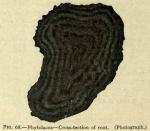Tropical plants represented in the United States by Phytolacca decandra and Rivinia laevis.
126. Phytolacca, N.F.—Poke root.
 The dried root of Phytolac'ca decan'dra Linné, collected in autumn.
The dried root of Phytolac'ca decan'dra Linné, collected in autumn.
BOTANICAL CHARACTERISTICS.—Stem red, 3 to 8 feet high, smooth, with an unpleasant odor. Leaves large, petiolate, alternate, ovate-lanceolate, entire, cuspidate. Racemes lateral, opposite the leaves; calyx (perianth) white, lobes ovate, rounded at the apex; ovary bright green, berries dark purplish-red, pulpy.
HABITAT.—North America; naturalized in West Indies and Southern Europe.
DESCRIPTION OF DRUG.—A large root, often 25 to 75 mm. (1 to 3 in.) in diameter, but cut into various sized transverse or longitudinal slices for drying and for the market; externally yellowish-brown, much wrinkled; internally grayish, turning yellow on exposure. Structure loosely fibrous, almost ligneous, alternating with dark, circular layers; a transverse slice shows on its face numerous concentric circles formed by the projecting ends of fibers between which the intervening parenchyma has shrunk; odor slight; taste sweetish, then acrid.
CONSTITUENTS.—Resin, tannin, starch, gum, sugar, fixed oil, salts, and probably a glucoside. A trace of alkaloid is reported, but the writer has found alkaloidal reaction quite pronounced in concentrated and purified solutions of the drug. Its virtues are imparted to water and alcohol.
ACTION AND USES.—Alterative, emetic, cathartic. It is not suitable for a cathartic however, because of the narcotic effect often produced. Its most important use is as an alterative in chronic rheumatism, etc., and externally, in the form of ointment, in various skin diseases. Dose: 3 to 30 gr. (0.2 to 2 Gm.). Emetic in the larger dose.
Fluidextractum Phytolacceae,(U.S.P. 1900), Dose: Emetic, 1.0 mil (15 drops.) Alterative 0.2 mil (3 drops).
127. Phytolaccae fructus. - Poke-berries.
127. PHYTOLACCAE FRUCTUS.—POKE-BERRIES. Globular, purplish or black, berry-like fruits, about 8 mm. (1/3 in.) or less in diameter, adhering together in masses from the exudation and drying of a purplish-red juice. Ten-celled, each containing a single glossy black seed imbedded in a succulent pulp. Inodorous; taste sweetish, slightly acrid, and nauseous. Constituents: Phytolaccin, phytolaccic acid, tannin, sugar, gum, and an evanescent coloring matter, turned yellow by alkalies and bleached by sunlight.

